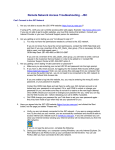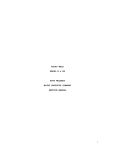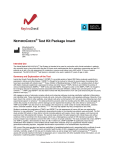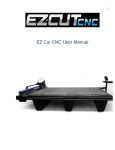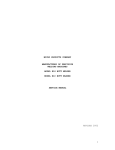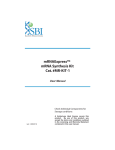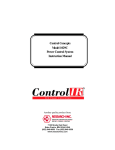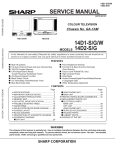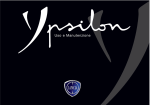Download model gp0 ceramic fusion butt welder
Transcript
MICRO PRODUCTS COMPANY MANUFACTURES OF PRECISION WELDING MACHINES MODEL GP0 CERAMIC FUSION BUTT WELDER SERVICE MANUAL 1 TABLE OF CONTENTS 1.0 2.0 3.0 4.0 5.0 6.0 7.0 8.0 9.0 10.0 11.0 12.0 13.0 1.0 SPECIFICATIONS GENERAL OPERATING INSTRUCTIONS BASIC OPERATING PARTS BASIC OPERATING PARTS LOCATION TYPICAL OPERATING SEQUENCE SPECIAL ADJUSTMENT PREVENTIVE MAINTENANCE SUGGESTED SETTINGS DIAGNOSTIC CHART FOR TROUBLE SHOOTING ELECTRICAL SCHEMATIC SAFETY REMINDERS BUYERS GUIDE PARTS LIST SPECIFICATIONS MODEL GP0 Stock Size Range Type Material Operating Voltage Input Power Cycle Line Demand Single Phase Weld Transformer Truck Mounted Welder Floor Space Overall Height Height to Welding Dies Welder Weight SUITABLE FOR BENCH MOUNTING Dimensions Overall Height Base Dimensions Height from Base to Welding Dies Welder Weight 26GA. to 18GA. Stranded copper conductor 115 Volts 60 Cycle (50 Cycle optional) 6 Amperes @100% Duty Cycle 19 Amperes @10% Duty Cycle 1.0 KVA @50% Duty Cycle 2 Stationary Casters 2 Swivel Casters 24” x 24” 57” 44” Approx. 120 LBS 29” 11” x 18” 12.5” Approx. 70LBS. 2 2.0 GENERAL OPERATING INSTRUCTIONS 2.1 ELECTRICAL HOOK-UP INSTRUCTIONS First determine that available electrical service in your plant corresponds to the nameplate rating located on welder housing. Electrical wiring to welder must be of sufficient size to deliver full ampere load with no appreciable loss during the weld cycle. The welder will not operate properly if there is more than a 10% variation in the line voltage. In general, the welder should be fused with a slow blow fuse of the 100% duty cycle rating. The minimum power cable size to the welder can be obtained by using this same current rating. Refer to National Electrical Code and local electrical regulations for adequate power sizes; disconnect methods and fusing guidelines. Remember line voltages to the welding machine are potentially dangerous should the power cords be damaged or severed. The welding voltages at the welding dies will not harm an operator since they do not exceed 10 volts. 2.2 SAFETY PRECAUTIONS 2.2.1 ELECTRICAL Maintain electrical cables to welder in good repair. Welders must be grounded and connections securely tightened. Heat switch must not be changed to a new position while a weld cycle is in process. Disconnect electrical service before servicing the welder – high voltages are located within the base of the welder. 2.2.2 MECHANICAL Operator while using welder must wear safety glasses. Keep all safety guards on welders and use properly. Operators must be instructed on the basic operation of unit to prevent injury. Check nameplate rating and keep within material size range for each welder. 2.3 WELDING DIES The dies and shoes supplied with the welder will handle most size and material types within the range of the welder. For new weld applications consult the factory for special die and shoe sets. 3 3.0 BASIC OPERATING PARTS 3.1 WELD HEAT SELECTION SWITCH Weld heat is selected by means of a tap switch with 10 steps of voltage. Number one indicates the highest setting and number ten the lowest. The switch is located in the front and center of the welder. (Ref. 4.0) 3.2 HEAD CLOSED SPACE SETTING Turning the insulated screw that rides the space-adjusting cam located on the top of the headpiece makes this adjustment. 3.3 HEAD OPEN SPACE SETTING A space-adjusting cam located on the top of the headpiece makes this adjustment. This setting determines the amount of burr that the weld will have. See charts for approximate settings. 3.4 LIMIT SWITCH SETTING The weld limit switch controls the cutoff point of current flow to the welding dies. Turning an adjusting screw located on the left end of the movable headpiece makes this adjustment. See Charts for setting. 3.5 UPSET PRESSURE Upset pressure adjustments are obtained by rotating the knurled knob on the right hand side of the stationary headpiece. When the outside edge of the adjusting screw is flush with outside edge of the knurled knob, the movable headpiece should just close when pulled to the left by hand and released. A calibrating screw and nuts located on the opposite left hand headpiece will assist in setting this positioning. Accompanying charts will assist in correct settings for various sizes of wire. 3.6 WELD INITIATING KNOB The push button knob that initiates the weld cycle is located on the right front of the welder enclosure. 4 4.0 BASIC OPERATING PARTS LOCATION 5 5.0 TYPICAL OPERATING SEQUENCE 5.1 5.2 5.3 5.4 5.5 5.6 5.7 Wire must be clean and free of dirt and oil. Set weld heat switch to recommended setting (Ref 8.0) Set hi-low range switch (Ref 8.0) Set upset pressure (Ref 8.0) Rotate space cam to open stop (1/4” between dies) Twist conductor end in direction of natural lay. Carefully square cut conductor ends so no individual wires extend beyond cut. Select correct size of ceramic sleeve. Thread conductor end into ceramic sleeve so as wire ends are midway through sleeve. Rotating ceramic in direction of wire lay will assist threading procedure. Clamp preset conductor and sleeve into welding die set, so as ceramic sleeve is centered between open welding dies. Thread other prepared conductor into sleeve and allow the conductor to gently but firmly contact first conductor. Positive contact to wire ends is important for good weld. Clamp that conductor into welding dies. Rotate and center ceramic sleeve to assure free movement of conductors during weld process. Rotate spacing lever to 0. Depress the operation switch, hold for 1 to 3 seconds to assure a complete weld cycle. Unclamp welded conductor and remove ceramic sleeve. Fracture expendable type sleeve. The inside diameter of ceramic sleeve slightly exceeds the nominal conductor size, therefore the weld zone is slightly larger than conductor diameter. An additional sizing operation, swaging, may be required should weld zone exceed tolerances on subsequent processing operations. Micro Products has a special swage tool with exchangeable tooling available to assist with this sizing operation. The above operation applies to either auto or manual. When the auto manual switch is in auto, the weld time will be limited to that selected on the timer. 5.8 5.9 5.10 5.11 5.12 5.13 5.14 5.15 5.16 5.17 5.18 6 6.0 SPECIAL ADJUSTMENT 6.1 HEADPIECE CLOSED SPACE ADJUSTMENT Closed space between dies should be 7/32” when the spaceadjusting cam is set at zero. To make this adjustment first move the space-adjusting cam to zero, then check the spacing between the dies. If the space between the dies is not 7/32” at this time, loosen the locknut on the space adjusting screw. Turn screw clockwise for more space and counterclockwise for less space. Once space has been set tighten the locknut on the space adjusting screw. 6.2 OPEN SPACE ADJUSTMENT This adjustment determines the amount of upset burr. The adjustment is made by the space-adjusting cam. A pointer reflects the cam positioning. Refer to accompanying charts for approximate settings. 6.3 WELD LIMIT SWITCH Do not put any wire in the dies when making this adjustment. Set the space-adjusting cam at #1 on cam. With a voltmeter measure across the clamp fingers with power applied to the welder. Press the weld button. The voltmeter reading should be approximately one VAC with welder at the highest heat setting. If no voltage is read move the space cam to higher number. Return the cam to #1 while watching the voltmeter. The voltage should shut off at #1 on the cam. Loosen locknut on the limit switch adjusting screw and adjust until the welder shuts off at #1 on the spaceadjusting cam. After setting tighten locknut on the limit switch adjusting screw. 6.4 UPSET PRESSURE Upset pressure adjustments are obtained by rotating knurled knob on right hand side of stationary headpiece. When outside edge of upset adjusting screw is flush with outside edge of thumb knob, movable headpiece should just close when pulled to the left by hand. A calibrating screw and nut located on right hand headpiece will assist in setting the neutral position. Accompanying charts will assist in correct setting for neutral position. Accompanying charts will assist in correct setting for various sizes of wire. 7 7.0 PREVENTIVE MAINTENANCE 7.1 AS REQUIRED: Flashings must be removed from between welding dies and clamp fingers with a brush. If flashings are attached so that they cannot be removed by brushing with a soft wire brush, they may be broken loose with a scraper made of fiber or wood. 7.2 DAILY: 7.2.1 Check condition of welding dies and clamp fingers. Replace Dies or clamp fingers when they have become so worn that stock does not align or there is slipping of stock in the dies during upset pressure. 7.2.2 Check condition of clamp springs. Replace all broken springs or springs that have taken a set. 7.2.3 Check movable head for excessive wear. Have new slide shafts installed and die seats machined if stock does not line up when placed in die grooves. 7.3 MONTHLY: 7.3.1 Remove welding dies and clean bottom of die surface with #120 emery cloth. Do this by placing the emery cloth on a flat surface plate and rubbing the dies on it, keeping the surface of the die flat. Wipe die and die seat with a clean cloth and replace, taking care not to touch either contact surface with the hand. 7.3.2 Check anneal dies and replace worn or broken parts. 7.3.3 Check insulating fiber pin on limit switch adjusting screw for broken or frayed ends. 7.3.4 Check upset tension spring and clamp springs. Replace if springs have been over-stretched and will not return to normal position. 7.4 QUARTERLY: 7.4.1 Disconnect power to welder. Check contacts on operating and limit switch. Replace those that are burned. 7.4.2 Check anneal dies and replace worn or broken parts. 7.4.3 Check insulating fiber pin on limit switch adjusting screw for broken or frayed ends. 7.4.4 Check upset tension spring and clamp springs. Replace if springs have been over-stretched and will not return to normal position. 8 7.5 ANNUALLY: 7.5.1 Remove the movable headpiece and check condition of slide shafts. Wash slide shafts with low residue cleaner, lightly oil and replace headpiece. 7.5.2 Check condition of headpiece castings. If worn or broken, replace with new headpiece. If welder is used in an area where there are corrosive fumes, clean off all oxides and paint where possible. 7.6 WELDING DIE INFORMATION Description: Welding dies – Lower conducting electrode and clamp jaw. Welding clamp fingers – Upper clamping member. WELDING DIES IN POOR CONDITION ARE THE MAIN CAUSES OF BAD WELDS. 7.6.0 CARE OF DIE SETS 7.6.1 Use a Brass or fiber blade to remove particles of flashings that build-up on die sets. Excessive flash build-up causes die burns on material and shorting of die sets. 7.6.2 Do not attempt to clamp material that is not suited for welder into die sets. Undersize materials will slip and burn die grooves, oversized materials will overstress clamping parts. 7.6.3 Do not use welding die sets for a vise. These parts will not withstand the mechanical abuse. 7.6.4 Whenever welding dies are replaces, clean bottoms of dies and corresponding die seats to a bright and clean condition before bolting them tightly into place. An oxidized surface will insulate the welding dies and reduce effective welding voltage. 7.6.5 Welding die sets will wear with use and must be changed occasionally for good welding results. Keep and adequate supply of replacement parts available. Wire and rod slippage is a problem caused by poor die sets and a major cause of wire breaks. 9 8.0 SUGGESTED SETTINGS STOCK STRANDED COPPER COPPER COPPER COPPER COPPER SIZE WIRE 26 24 22 20 18 GA. GA. GA. GA. GA. HEAT TENSION HEADPIECE OPEN SPACE 10H 9H 8H 7H 6H 1 1.5 2 3 3.5 5 6 6 6 7 LIMIT SWITCH NOTE: These settings are approximate and may be varied to suit needs. 8.1 WELDED STRAND OR BUNCHED COPPER AND ALUMINUM WIRE CONDUCTORS THEORY: Welds are formed within a ceramic tube of block and no filler materials are needed. Wire ends are resistance heated to a plastic condition and hot forged together within a ceramic tool, which acts as a crucible. The resultant coalescence (weld) locks all single filaments into a solid weld zone…Since strand conductors have configuration voids on the fraying surfaces, the plastic material normally forced to the outside on a normal weld, is forced into the voids eliminating the upset burr common with standard upset welds. (This type of weld is not suitable for solid wire.) 10 8.2 CERAMIC FUSION TECHNIQUE 11 9.0 DIAGNOSTIC CHART FOR TROUBLE-SHOOTING WELDERS WELDING ACTION CAUSE REMEDY Molten metal is blown out and ends not joined Weld heat too high Stock is too small Low upset pressure Upset pressure too great Lower heat settings Check size rating of welder Adjust upset Lower upset pressure Welding dies & clamp fingers Replace worn dies and clamp fingers Decrease starting space Return heads to factory Decrease starting space Increase weld heat Check Clamp finger pressure Check electric lines Clean and tighten transformer connections to heads Clean wire where clamped in dies Replace dies Clean build-up of flash materials Weld is complete but is dry and breaks off below surface of wire Weld good but poorly aligned Ends of wire buckle and may not weld Varying weld results Starting space Loose shafts Upset pressure too great Low weld heat Stock slipping Varying weld voltages Wire condition variations Dies Flashings 9.1 ELECTRICAL TROUBLE-SHOOTING OF WELDER (CAUTION! Extreme care should be exercised when making these tests. Dangerous voltages are present in the welder. Only persons familiar with electrical safety precautions should perform these tests.) 9.1.1 TROUBLE-SHOOTING TABLE (See section 9.1.3) This electrical trouble-shooting table is furnished as a suggested method of trouble-shooting the welder. The individual steps of the table should be performed in the order given, to make the tests valid. The electrical schematic (section 10) furnished for these tests show the table test points. The table may be used for welders with a different but closely related wiring by using corresponding test points. (During all tests, line voltage should be connected to L1 & L2 of the welder. The heat switch should be set to the #1 position. 9.1.2 FINAL ELECTRICAL CHECKS Set the heat switch to the number 1 position, connect the voltmeter across the welding dies. Press the operating switch. The meter reading will typically be less than 10 VAC. Consult the weld specification sheet for this value. 12 Rotate the heat switch through all settings. If the voltage is not read at any setting, the heat switch may be defective. Actuate the weld limit switch; observe the reading goes to zero. Release the weld limit and operating switches, the reading should remain at zero. 9.1.3 TEST LEAD CONNECTION L2 FU1-1 L2 FU1-2 METER READING 115VAC 115VAC L2 PB1-1 115VAC L2 PB1-2 L2 LS1-1 115VAC 115VAC L2 L2 L2 L2 L2 LS1-2 CR1-1 CR1-2 S1-1 TR1-8 115VAC 115VAC 115VAC 115VAC 115VAC* PROBLEM IF NO READING Bad fuse connection Open fuse Open wire to operating switch Bad operating switch Open connection to weld limit switch Open weld limit switch Open wire to contactor Bad contactor Open wire to heat switch Bad timer circuit momentary PRESS OPERATING SWITCH WELD LMIT SWITCH ACTUATED AUTO/MANUAL SWITCH MANUAL X X X X AUTO Note: to perform repair consult section 13 for parts identification. S2 closed for all tests. *Voltage present for 1 sec. when timer is set to 1 sec. 13 14 11.0 SAFETY REMINDERS The following accident prevention information is presented to eliminate potential hazards while operating, inspecting or repairing Micro-Weld Electric resistance welding equipment. Important safety compliance information for Micro-Weld Welders. GENERAL 1. Qualified personnel, prior to using equipment, must instruct an operator on basic operation and malfunction methods. 2. Safety eyeglasses must be worn by all personnel operating or servicing welders. 3. Use safety equipment properly and keep safety equipment on welders. 4. Determine that both operating voltages and hertz (cycles) of power supply correspond to ratings listed on welder nameplate located on welder housing. 5. Check nameplate ratings and keep within capacities and material categories stated therein. 6. Adjustments or repairs must be made by persons thoroughly familiar with operating principles of welder. 7. Welder must be disconnected from power supply prior to maintenance or repair procedures. ELECTRICAL 1. Refer to national Electrical Code and local regulations for adequate electrical wiring to power welder. Do not operate welder with inadequate electrical power supply cords or cable. 2. All welders must be grounded through power supply and welder ground connection terminal securely tightened. 3. All welders must be able to be disconnected from power source either by a double breaking disconnect switch or unplugged by standard rated plugs. 4. All welders must be fused to prevent injury should an electrical malfunction occur. Welders must never be fused for an ampere load that exceeds the ratings stated on welder nameplate. Normally welders are fused using the nameplate rated load; time lag parameters functional to standard fuse allow this specification. 5. Electric power cords to welder must be kept in good condition. Report any damage or potential hazards to maintenance personnel. 6. The weld head selection switch, potentiometer or range selection devices must not be changed to a new position while a weld operation is in process. 15 12.0 BUYERS GUIDE HOW TO ORDER PARTS: You must provide 1. Machine Model 2. Machine Serial Number 3. Voltage Then identify part(s) on part list in section 13 and provide MICRO with the circled number CALL MICRO at A.C. 630-787-9350 Or Toll free at 800-872-1068 Provide MICRO with your company name and purchase order number. 16 13.0 PARTS LIST 17 18 19 PARTS LIST GPO MODEL/ PART NO. DESCRIPTION GPO-01A Head assembly GPO-03 Tray assembly GPO-04 Transformer cap GPO-05A Basic head assembly GPO-05B Interior mounting plate GPO-05C Cherry micro switch GPO-06A Basic head assembly GPO-06B Bearing spacer GPO-06C Bearing GPO-06D Limit switch adjusting screw GPO-06E Shaft cover GPO-07A Open head stop screw GPO-14 Housing assembly GPO-14C Basic head brass pin GPO-14E Basic head groove pin GPO-14FP Front door GPO-14BP Back door GPO-18 Shunt insulator GPO-21 Tension adjusting knob GPO-22 Tension adjusting worm GPO-23 Tension screw nylon GPO-24 Tension spring GPO-25A Space cam assembly GPO-26 Repeating cam stop GPO-27 Cam bushing GPO-28 Space cam attaching bolt GPO-29 Closed space adjusting screw GPO-34 Insulating sleeve GPO-38 End cover plate GPO-39 End cover attaching screw GPO-51A Omron timer GPO-51B Omron socket GPO-51C Omron adapter GPO-51D Omron cover GPO-53 Fuse holder GPO-54 Fuse GPO-62 Tap switch plate GPO-63 Tap switch GPO-64 Heat switch plate GPO-68 GPO radius groove dies (20 & 18 ga) GPO-69 GPO radius groove dies (22-24-26 ga) GPO-70 Clamp finger left wide GPO-71 Clamp finger right wide GPO-74 Finger stop pin GPO-75 Clamp finger return spring GPO-76 Basic head spring screw ITEM # 32118 42051 52001 32133 32132 57851 32133 32057 48400 52008 32056 32028 42075 93144 92608 42050 42033 37728 35564 32087 35516 32059 32003 32000 32002 90203 32082 37709 32054 91055 57693 57695 57694 57696 58091 58083 55510 57800 55510 32123 32124 32016 32017 32020 80007 91026 20 PARTS LIST GPO MODEL/ PART NO. DESCRIPTION GPO-77 Finger attaching screw GPO-90 Cable GPO-91 Kellum grip GPO-100 Back panel knob GPO-101 Terminal block assembly GPO-105 Operating switch GPO-106 Hi-low switch GPO-107 Auto manual nameplate GPO-108 Operating switch plate GPO-109 On-off switch GPO-109A Auto-manual switch GPO-110 Hi-low nameplate GPO-111 On-off nameplate GPO-112 Truck assembly GPO-119 Shear GPO-138 Lamp GPO-141 Transformer GPO-142 Transformer ring GPO-143 Rod GPO-185 Contactor ITEM # 32064 86006 86100 48216 42509 57843 57843 52034 52035 57839 57840 48306 48305 42026 64002 58164 52049 54512 93000 57613 21





















